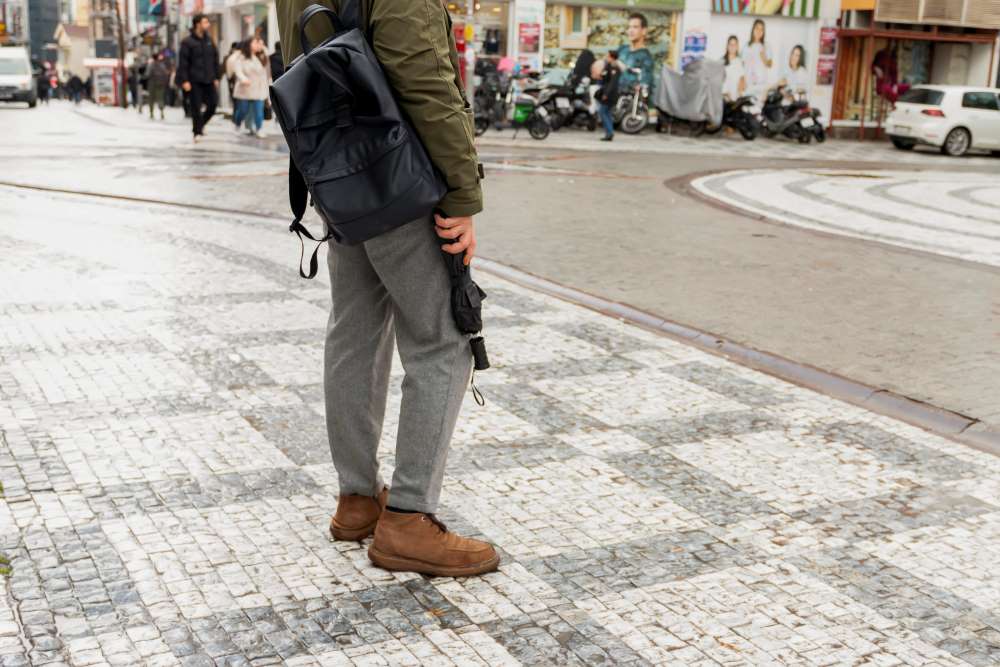
Wet weather can turn even a short walk into a hazardous experience. Whether it’s a light drizzle or a heavy downpour, rain creates slippery surfaces, reduces visibility, and makes everyday paths more dangerous. However, with a little preparation and some common-sense strategies, you can reduce your chances of slipping, falling, or injuring yourself when walking in wet conditions. If you believe that negligence contributed to your injury, it’s wise to seek expert legal advice.
Here are some walking safety tips to help you stay on your feet and avoid personal injury when the weather takes a turn for the worse.
1. Choose Proper Footwear
One of the most important ways to prevent a fall in wet weather is by wearing the right shoes. Footwear with good traction is crucial, as smooth soles are much more likely to slip on wet pavement or tile. Look for shoes or boots that have non-slip rubber soles with a tread pattern designed for grip. These types of shoes help maintain balance on slippery surfaces, whether you're walking on sidewalks, stairs, or crossing a wet street.
Additionally, make sure your footwear is waterproof, especially if you'll be walking for extended periods in the rain. Wet feet not only make walking uncomfortable but can also lead to blisters, which may cause you to change your stride and increase the risk of falling.
2. Watch Your Step and Slow Down
In wet weather, rushing can be dangerous. Slowing down gives you more control over your movements and allows you to respond more quickly if you start to lose balance. When walking on wet surfaces, take smaller steps and be mindful of where you're placing your feet.
Be especially cautious on surfaces that are prone to becoming slippery when wet, such as tiled sidewalks, painted road markings, and metal grates. These areas can be hidden hazards during a rainstorm, and taking extra care when walking over them can significantly reduce the risk of slipping.
When going up or down stairs, hold onto handrails if available and avoid rushing. Wet staircases are notorious for causing slip-and-fall accidents, so taking your time is key to preventing injuries.
3. Use Weather-Appropriate Gear
Carrying an umbrella, wearing a rain jacket, or using a hood are all good ways to protect yourself from the elements. However, make sure you are using these items in a way that doesn’t obstruct your vision or limit your ability to move safely. For instance, large umbrellas can sometimes make it difficult to see where you're walking or keep an eye on potential hazards, such as uneven ground or oncoming traffic.
Consider investing in a compact umbrella that offers protection without blocking your field of vision. A well-fitted rain jacket with a hood that doesn’t obstruct your sight is also a great alternative. Wearing reflective clothing is another essential precaution if you’re walking in low visibility, especially during early morning or evening hours. Reflective gear helps drivers and other pedestrians see you clearly, reducing the likelihood of accidents.
4. Stay Alert to Your Surroundings
Rainy weather can create additional distractions, from the sound of the rain to the need to manage your umbrella or jacket. However, staying alert to your surroundings is crucial for preventing accidents. Pay attention to your footing and avoid looking at your phone or getting too distracted by other tasks while walking.
Watch out for puddles, as stepping into one could not only soak your feet but may hide uneven surfaces, potholes, or debris that could cause you to trip. Be extra cautious near crosswalks or areas where vehicles may have difficulty stopping quickly due to the wet roads.
5. Be Cautious Around Traffic
Wet weather affects drivers as well as pedestrians. Cars need more time to stop on wet roads, and visibility is often reduced during rainstorms, which can increase the risk of accidents. When crossing streets, make sure to wait until it is safe and clear to do so. Never assume that a driver can see you, especially if rain or fog is present.
If possible, cross at designated crosswalks, and make eye contact with drivers before stepping out onto the road. Staying aware of the traffic around you, combined with wearing reflective clothing, will help keep you safe in conditions where drivers might not see you right away.
Wet weather brings added challenges to walking safely, but with the right footwear, a cautious approach, and awareness of your surroundings, you can significantly reduce your risk of injury. Always remember that your safety comes first, and knowing how to stay safe in slippery conditions will help you enjoy your walk, rain or shine.



























